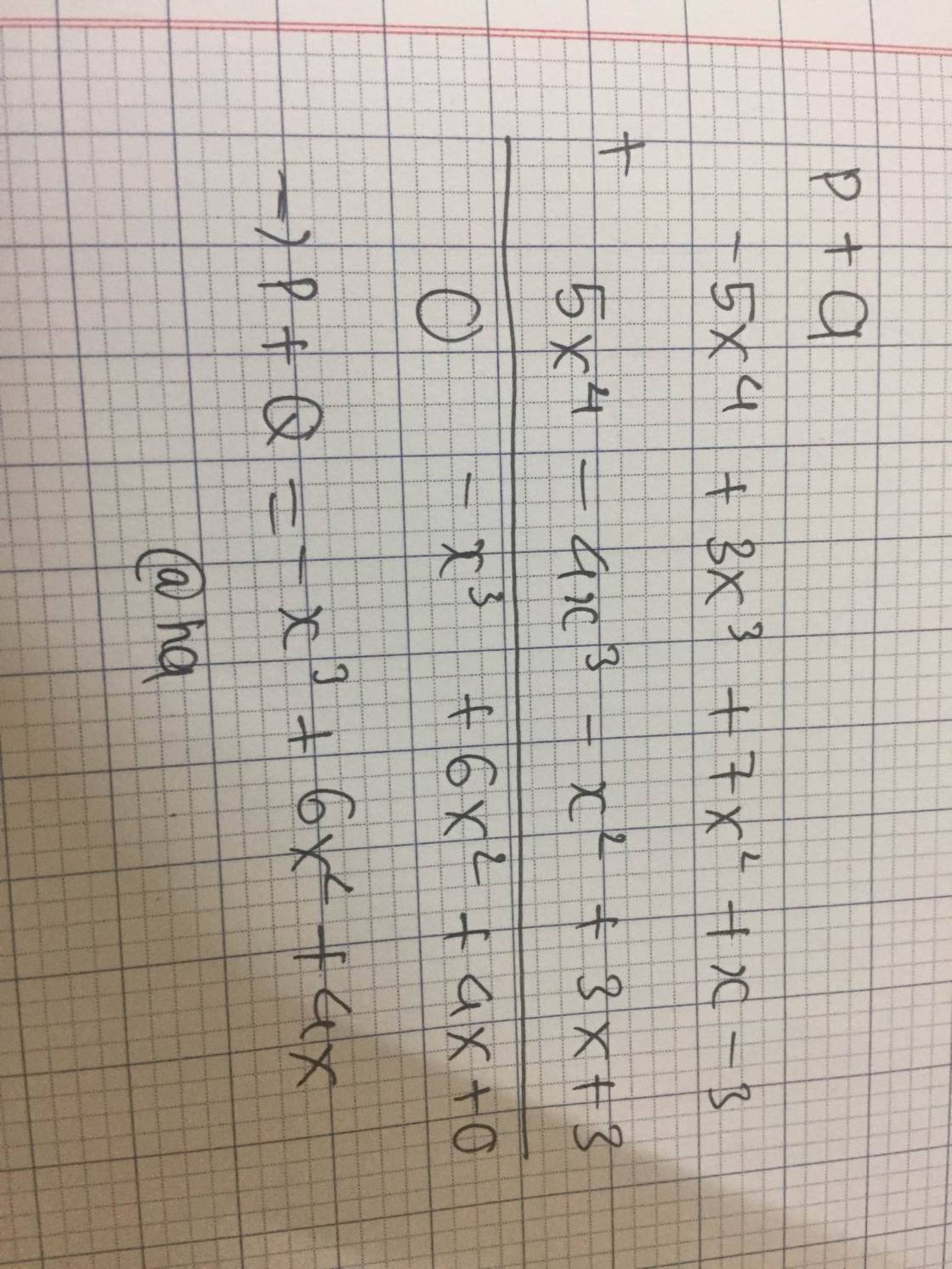3x3 -7x2 +17x - 5=0

Những câu hỏi liên quan
1) x4 - 8x2 + 4x + 3 = 0
2) x4 - 3x3 - 7x2 + 24x - 8 = 0
3) x4 - x3 - x2 + x + 1 = 0
Giải phương trình??? sử dụng Hooc-ne cho nhanh nhá :v
1) \(x^4-8x^2+4x+3=0\)
( dùng máy tính ta đoán được 1 nghiệm chính xác là -3 )
\(\Leftrightarrow\left(x+3\right)\left(x^3-3x^2+x+1\right)=0\)
\(\Leftrightarrow\left[{}\begin{matrix}x+3=0\\x^3-3x^2+x+1=0\left(2\right)\end{matrix}\right.\)
Tiếp tục dùng máy tính ta tìm được 1 nghiệm chính xác của pt ( 2 ) là 1
\(\Leftrightarrow\left(x+3\right)\left(x-1\right)\left(x^2-2x-1\right)=0\)
\(\Leftrightarrow\left[{}\begin{matrix}x+3=0\\x-1=0\\x^2-2x-1=0\end{matrix}\right.\Leftrightarrow\left[{}\begin{matrix}x=-3\\x=1\\x=1+\sqrt{2}\\x=1-\sqrt{2}\end{matrix}\right.\)
rồi mấy câu còn lại tương tự
Đúng 1
Bình luận (0)
Tính
1. ( - 4xy ) . ( 2xy2 - 3x2y)
2. ( -5x ) ( 3x3 + 7x2 - x )
3. ( 3x - 2 ) ( 4x + 5 ) - 6x ( 2x -1 )
4. 2x2 ( x2 - 7x + 9 )
5. ( 3x - 5 ) ( x2 - 5x + 7 )
`@` `\text {Ans}`
`\downarrow`
`1.`
\(\left(-4xy\right)\cdot\left(2xy^2-3x^2y\right)\)
`=`\(\left(-4xy\right)\left(2xy^2\right)+\left(-4xy\right)\left(-3x^2y\right)\)
`=`\(-8\left(x\cdot x\right)\left(y\cdot y^2\right)+12\left(x\cdot x^2\right)\left(y\cdot y\right)\)
`=`\(-8x^2y^3+12x^3y^2\)
`2.`
\(\left(-5x\right)\left(3x^3+7x^2-x\right)\)
`=`\(\left(-5x\right)\left(3x^3\right)+\left(-5x\right)\left(7x^2\right)+\left(-5x\right)\left(-x\right)\)
`=`\(-15x^4-35x^3+5x^2\)
`3.`
\(\left(3x-2\right)\left(4x+5\right)-6x\left(2x-1\right)\)
`=`\(3x\left(4x+5\right)-2\left(4x+5\right)-12x^2+6x\)
`=`\(12x^2+15x-8x-10-12x^2+6x\)
`=`\(\left(12x^2-12x^2\right)+\left(15x-8x+6x\right)-10\)
`=`\(13x-10\)
`4.`
\(2x^2\left(x^2-7x+9\right)\)
`=`\(2x^2\cdot x^2+2x^2\cdot\left(-7x\right)+2x^2\cdot9\)
`=`\(2x^4-14x^3+18x^2\)
`5.`
\(\left(3x-5\right)\left(x^2-5x+7\right)\)
`=`\(3x\left(x^2-5x+7\right)-5\left(x^2-5x+7\right)\)
`=`\(3x^3-15x^2+21x-5x^2+25x-35\)
`=`\(3x^3-20x^2+46x-35\)
Đúng 4
Bình luận (0)
3x3-7x2+5x-1/2x3-x2-4x+3
Nhận thấy tử và mẫu phân thức đều có tổng các hệ số bằng 0, Theo Bezout ta có : \(3x^3-7x^2+5x-1⋮x-1,2x^3-x^2-4x+3⋮x-1\)
Thực hiện phép chia ta sẽ có biểu thức
=\(\frac{\left(x-1\right)\left(3x^2-4x+1\right)}{\left(x-1\right)\left(2x^2+x-3\right)}=\frac{3x^2-4x+1}{2x^2+x-3}\).Ta lại thấy tử và mẫu có tổng các hệ số bằng 0, theo Bơ du chúng sẽ chia ht x-1.Thực hiện phép chia rồi rút gọn đc
\(\frac{3x-1}{2x+3}\)
Tích của đa thức 4x5 + 7x2 và đơn thức -3x3 là?
\(-3x^3\left(4x^5+7x^2\right)=-12x^8-21x^5\)
Đúng 1
Bình luận (0)
Tích của đa thức
4
x
5
+
7
x
2
và đơn thức
(
-
3
x
3
)
là: A.
12
x
8
+
21
x
5
B.
12
x
8...
Đọc tiếp
Tích của đa thức 4 x 5 + 7 x 2 và đơn thức ( - 3 x 3 ) là:
A. 12 x 8 + 21 x 5
B. 12 x 8 + 21 x 6
C. - 12 x 8 + 21 x 5
D. - 12 x 8 – 21 x 5
( 4 x 5 + 7 x 2 ) . ( - 3 x 3 ) = 4 x 5 . ( - 3 x 3 ) + 7 x 2 . ( - 3 x 3 ) = - 12 x 8 – 21 x 5
Đáp án cần chọn là: D
Đúng 0
Bình luận (0)
P= -5x4+3x3+7x2+x-3 và Q=5x4 - 4x3 - x2 +3x +3, p+Q
A=5x3-7x2-(-3x3+4x2)+(x2-x3+5x-1)
B=(3x2+5x3-7x4)-(5x3-4x2+x4-3)
\(A=5x^3-7x^2+3x^3-4x^2+x^2-x^3+5x-1=7x^3-10x^2+5x-1\)
\(B=5x^3+3x^2-7x^4-5x^3+4x^2-x^4+3=-8x^4+7x^2+3\)
Đúng 2
Bình luận (1)
\(A=7x^3-10x^2+5x-1\)
\(B=-8x^4+7x^2+3\)
Đúng 0
Bình luận (0)
Cho hai đa thức f (x)3x3 +5x−2x2 −7 và g(x)3x3 −(2x2 −5x)+7x2 +3 a/ Thu gọn và sắp xếp f(x), g(x) theo thứ tự bậc giảm dần. Tìm bậc của chúng b/Tính N(x)g(x)−f(x) và M(x)2.f(x)+g(x) c/ Tính giá trị của M(x) biết x2-3x0 d/ Tìm giá trị nhỏ nhất của N(x).
Đọc tiếp
Cho hai đa thức f (x)=3x3 +5x−2x2 −7 và g(x)=3x3 −(2x2 −5x)+7x2 +3
a/ Thu gọn và sắp xếp f(x), g(x) theo thứ tự bậc giảm dần. Tìm bậc của chúng b/Tính N(x)=g(x)−f(x) và M(x)=2.f(x)+g(x)
c/ Tính giá trị của M(x) biết x2-3x=0 d/ Tìm giá trị nhỏ nhất của N(x).
a: F(x)=3x^3-2x^2+5x-7
G(x)=3x^3-2x^2+5x+7x^2+3=3x^3+5x^2+5x+3
Bậc của F(x),G(x) đều là 3
b: N(x)=G(x)-F(x)
\(=3x^3+5x^2+5x+3-3x^3+2x^2-5x+7=7x^2+10\)
M(x)=2F(x)+G(x)
\(=6x^3-4x^2+10x-14+3x^3+5x^2+5x+3\)
\(=9x^3+x^2+15x-11\)
c: x^2-3x=0
=>x=0 hoặc x=3
\(M\left(0\right)=9\cdot0^3+0^2+15\cdot0-11=-11\)
\(M\left(3\right)=9\cdot3^3+3^2+15\cdot3-11=286\)
d: N(x)=7x^2+10>=10
Dấu = xảy ra khi x=0
Đúng 1
Bình luận (0)
Câu 1 (3,0 điểm): Tínha) 3x2 (2x2 − 5x − 4)b) (x + 1)2 + ( x − 2 )(x + 3 ) − 4xc) (6 x5 y2 − 9 x4 y3 +12 x3 y4 ) : 3x3 y2Câu 2 (4,0 điểm): Phân tích đa thức thành nhân tửa) 7x2 +14xy b) 3x + 12 − (x2 + 4x)c ) x2 − 2xy + y2 − z2 d) x2 − 2x −15Câu 3 (0,5 điểm): Tìm xa) 3x2 + 6x 0 b) x (x − 1) + 2x − 2 0Câu 4 (2,0 điểm): Cho hình bình hành ABCD (AB BC). Tia phân giác của góc D cắt AB ở E, tia phân giác của góc B cắt CD ở F.a) Chứng minh DE song song BFb) Tứ giác DEBF là hình gì?Câu 5 (0,5 điểm )...
Đọc tiếp
Câu 1 (3,0 điểm): Tính
a) 3x2 (2x2 − 5x − 4)
b) (x + 1)2 + ( x − 2 )(x + 3 ) − 4x
c) (6 x5 y2 − 9 x4 y3 +12 x3 y4 ) : 3x3 y2
Câu 2 (4,0 điểm): Phân tích đa thức thành nhân tử
a) 7x2 +14xy b) 3x + 12 − (x2 + 4x)
c ) x2 − 2xy + y2 − z2 d) x2 − 2x −15
Câu 3 (0,5 điểm): Tìm x
a) 3x2 + 6x = 0 b) x (x − 1) + 2x − 2 = 0
Câu 4 (2,0 điểm): Cho hình bình hành ABCD (AB > BC). Tia phân giác của góc D cắt AB ở E, tia phân giác của góc B cắt CD ở F.
a) Chứng minh DE song song BF
b) Tứ giác DEBF là hình gì?
Câu 5 (0,5 điểm ):
Chứng minh rằng A= n3 + (n+1)3 + (n+2)3 chia hết cho 9 với mọi n ∈ N*
\(1,\\ a,=6x^4-15x^3-12x^2\\ b,=x^2+2x+1+x^2+x-3-4x=2x^2-x-2\\ c,=2x^2-3xy+4y^2\\ 2,\\ a,=7x\left(x+2y\right)\\ b,=3\left(x+4\right)-x\left(x+4\right)=\left(3-x\right)\left(x+4\right)\\ c,=\left(x-y\right)^2-z^2=\left(x-y-z\right)\left(x-y+z\right)\\ d,=x^2-5x+3x-15=\left(x-5\right)\left(x+3\right)\\ 3,\\ a,\Leftrightarrow3x\left(x+2\right)=0\Leftrightarrow\left[{}\begin{matrix}x=0\\x=-2\end{matrix}\right.\\ b,\Leftrightarrow\left(x-1\right)\left(x+2\right)=0\Leftrightarrow\left[{}\begin{matrix}x=1\\x=-2\end{matrix}\right.\)
Đúng 0
Bình luận (0)
Câu 1
a)\(3x^2\left(2x^2-5x-4\right)=6x^4-15x^3-12x^2\)
b)\(\left(x+1\right)^2+\left(x-2\right)\left(x+3\right)-4x=x^2+2x+1+x^2+3x-2x-6-4x=2x^2-x-5\)
Đúng 0
Bình luận (0)
Bài 2
a) \(7x^2+14xy=7x\left(x+2y\right)\)
b) \(3x+12-\left(x^2+4x\right)=-x^2-x+12=\left(-x+3\right)\left(x+4\right)\)
c) \(x^2-2xy+y^2=\left(x-y\right)^2\)
d) \(x^2-2x-15=x^2+3x-5x-15=\left(x+3\right)\left(x-5\right)\)
Đúng 0
Bình luận (0)
|17x -5 | - |17x+5 | =0
=>|17x-5|=|17x+5|
=>17x-5=17x+5(vô lý) hoặc 17x-5=-17x-5
=>34x=0
hay x=0
Đúng 1
Bình luận (0)
\(\left|17x-5\right|=\left|17x+5\right|\)
\(\Leftrightarrow\left[{}\begin{matrix}17x-5=17x+5\\17x-5=-5-17x\end{matrix}\right.\Leftrightarrow\left[{}\begin{matrix}-5=5\left(loai\right)\\34x=0\end{matrix}\right.\Leftrightarrow x=0\)
Đúng 1
Bình luận (0)
\(\Leftrightarrow\left|17x-5\right|=\left|17x+5\right|\)
Xét \(17x-5\ge0\)
\(\Rightarrow17x-5=17x+5\left(voli\right)\)
Xét \(17x-5< 0\)
\(\Rightarrow17x-5=-17x-5\)
\(\Leftrightarrow34x=0\Leftrightarrow x=0\)
Vậy \(S=\left\{0\right\}\)
Đúng 0
Bình luận (0)






























